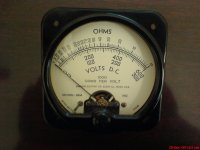I have builted the tubelab SE and I just wonder how to put in the Volts D.C. panel meter to monitor the B+ voltage. Advices are greatly appreciated!
Regards,
Binh
Regards,
Binh
Wire it in parallel...just like you'd test it with a DMM 🙂
Good meters are available from places like Surplus Sales of Nebraska or Mouser...
Good meters are available from places like Surplus Sales of Nebraska or Mouser...
I did a test which hook it up the Simpson (ohms per volt 600 DCV) with a power supply 9 DCV at 0-25 mA and the needle went all the way. I think it needs a circuitry to do a job.
Probably the meter is just an ammeter and it expects a series resistor.
Look for a marking that gives the FSD (Full Scale Deflection) current. You can use this with the meter resistance to calculate the value of resistor required.
This link: RADIO AMATEUR EXAM
explains far better than I can.
Look for a marking that gives the FSD (Full Scale Deflection) current. You can use this with the meter resistance to calculate the value of resistor required.
This link: RADIO AMATEUR EXAM
explains far better than I can.
Something I'd do: put a Zener diode of around 100V to 200V inseries with the meter and its resistor. That way you shift the meter zero by 100V or 200V or whatever you want. Then your meter scale runs from 100V up to 250V ( or 200V-350V) or whatever you want, instead of 0v up to 250V. This give a more acurate expanded scale, since measuring below 100V is not really useful.
6Meg is very high, you must have a sensitive meter. What is the FSD current rating?
In any event, connecting the whole network (meter + series resistor) in parallel with R30 is correct. It will not affect the voltage in any measurable way.
In any event, connecting the whole network (meter + series resistor) in parallel with R30 is correct. It will not affect the voltage in any measurable way.
The volt panel meter Simpson I have is not directed hook up and it needs the 6 meg-ohms resistor in series to be function right. I just wonder would it change the B+ if I have it in parallel with R30 and what are the effects? Schematic
If this is the same meter you connected across the supply previously without the required series resistor it is highly likely that the meter has been damaged by the experience. I would test the meter with an appropriate series resistor before making any plans to install it permanently. (Most likely it is a sensitive micro-ammeter and it has been exposed to a current many orders of magnitude greater than it was designed for.) Hopefully you have another meter you can install.
I try to find the data for my meter but couldn't find it. On the meter I found these info.
1000 ohms per volt
Simpson Electric Co. Elgin , Ill 60120 U.S.A.
Model 324 NO.
The Volt scale is : 0 200 400 600
0 100 200 300
I want to use it with 600 volt scale and by my calculation that I have to use 600,000 ohms or 600K, but it couldn't handle when I tried to measure 9V battery.
I just used the 2.2meg then it seem work and finally I use 6meg and tried with the power supply at 600 volts to test it. If you see some thing wrong please correct me.
1000 ohms per volt
Simpson Electric Co. Elgin , Ill 60120 U.S.A.
Model 324 NO.
The Volt scale is : 0 200 400 600
0 100 200 300
I want to use it with 600 volt scale and by my calculation that I have to use 600,000 ohms or 600K, but it couldn't handle when I tried to measure 9V battery.
I just used the 2.2meg then it seem work and finally I use 6meg and tried with the power supply at 600 volts to test it. If you see some thing wrong please correct me.
If the meter is working with the value you fit, then all is fine. There's nothing wrong with empirical methods.
I think Kevin perhaps thought that you'd connected it to 300v without any resistor, in which case 😱
I think Kevin perhaps thought that you'd connected it to 300v without any resistor, in which case 😱
No, Hardly any wattage at all. Work out the power yourself: V*V/R.
But you must consider that maximum voltage a resistor can stand. Unless they are specially designed for high voltage, I would use 2 resistors in series.
But you must consider that maximum voltage a resistor can stand. Unless they are specially designed for high voltage, I would use 2 resistors in series.
- Status
- Not open for further replies.
- Home
- Design & Build
- Parts
- Volts D.C. panel meter for B+
